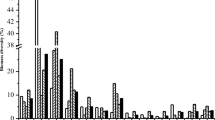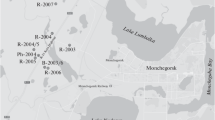Abstract
The necessity and urgency of remediating soil polluted with heavy metals have been recognized both politically and socially at the global level. Phytoremediation is a sustainable technology to remove or stabilize heavy metals in soil at former mine sites. The aim of this study was to clarify the ability of the tree species Koelreuteria bipinnata to phytoremediate heavy metal (Mn, Zn, Pb, and Cd)-contaminated soils. Concentrations of the four heavy metals were measured in soils from an un-remediated plot and from three K. bipinnata stands of different ages at the former Xiangtan manganese (Mn) mine, also forest stand growth and heavy metal concentrations were measured within different tissue of trees at three stands planted in heavy metal-contaminated soil for different years. The results showed that stand biomass of trees increased from 2.32 t ha−1 for 3-year-old trees, through 34.11 t ha−1 at 5 years, to 102.06 t ha−1 at 9 years. Total and individual heavy metal concentrations accumulated in the trees also increased with stand age; 9-year-old trees had accumulated 2.18 times the total heavy metals as the 3-year-old trees. Furthermore, soil heavy metal concentrations significantly (p < 0.05) decreased as stand age increased; total heavy metal concentrations in the contaminated soils remediated by 9-year-old trees were 85.29 % lower than its un-remediated plot. The results indicate that K. bipinnata is a suitable accumulator species to remediate Mn, Zn, Pb, and Cd pollution on mining wasteland.





Similar content being viewed by others
References
Abumaizar RJ, Smith EH (1999) Heavy metal contaminants removal by soil washing. J Hazard Mater 70(1–2):71–83
Alexander AK, Daniel VDL (2000) Chemical and biological parameters as tools to evaluate and improve heavy metal phytoremediation. Biosci Rep 20(4):239–258
Andon V, Jean-Paul S, Theo T, Daniel VDL, Jaco V (2004) The use of plants for remediation of metal-contaminated soils. Sci World J 4:9–34
Barcelo J, Poschenrieder C (2003) Phytoremediation: principles and perspectives. Contrib Sci 3(2):333–334
Brunetti G, Farrag K, Rovira PS, Nigro F, Senesi N (2011) Greenhouse and field studies on Cr, Cu, Pb and Zn phytoextration by Brassica napus from contaminated soils in the Apulia region, Southern Italy. Geoderma 160:517–523
Chen HM, Zheng CR, Tu C, Shen ZG (2000) Chemical methods and phytoremediation of soil contaminated with heavy metals. Chemosphere 41:229–234
Cheng SF, Huang CY, Lin YC, Lin SC, Chen KL (2015) Phytoremediation of lead using corn in contaminated agricultural land—an in situ study and benefit assessment. Ecotoxicol Environ Saf 111:72–77
China National Environmental Monitoring Centre (1990) Soil background value in China. China Environment Science Press, Beijing (in Chinese)
Dickinson NM, Pulford ID (2005) Cadmium phytoextraction using short-rotation coppice Salix: the evidence trail. Environ Int 31(4):609–613
Doument S, Lamperi L, Checchini L et al (2008) Heavy metal distribution between contaminated soil and Paulownia tomentosa, in a pilot-scale assisted phytoremediation study: influence of different complexing agents. Chemosphere 72:1481–1490
Drew AP, Guth RL, Greatbatch W (2000) Variation in heavy metal accumulation by hybrid poplar clones on sludge amended soil. Eco Soc China 1:109–117
Ebbs SD, Kochian LV (1997) Toxicity of zinc and copper to Brassica species: implications for phytoremediation. J Environ Qual 26:776–781
Felix H (1997) Field trials for in situ decontamination of heavy metal polluted soils using crops of metal-accumulating plants. J Plant Nutr Soil Sci 160:525–529
Feng DL, Li W, Zhang J et al (2009) Observation of somatic embryogenesis and histology in Koelreuteria bipinnata Franch var. integrifoliola T. Chen. Plant Physiol Commun 45(9):855–858
Freitas H, Prasad MNV, Praatas J (2004) Plant community tolerant to trance elements growing on the degraded soils of Sao Domingos mine in the south east of Portugal: environmental implications. Environ Int 30(1):65–72
Ghosh M, Singh SP (2005) A review on phytoremediation of heavy metals and utilization of it’s by products. Asian J Energy Environ 6(04):214–231
Guo ZH, Zhu YG (2004) Contamination and available contents of heavy metals in soils in the typical mining and smelting circumjacent districts. Eco Environ 13(4):553–555 (in Chinese)
Hughes JB, Shanks J, Vanderford M, Lauritzen J, Bhadra R (1997) Transformation of TNT by aquatic plants and plant tissue cultures. Environ Sci Technol 31(1):266–271
Keller C, Hammer D, Kayser A et al (2003) Root development and heavy metal phytoextraction efficiency: comparison of different plant species in the field. Plant Soil 249(1):67–81
Labrecque M, Teodorescu TI, Daigle S (1994) Effect of sludge application on early development of two Salix species: productivity and heavy metals in plants and soil solutions. In: Aronsson P (ed) Willow vegetation filters for municipal wastewaters and sludges. A biological purification system. Swedish University of Agricultureal Sciences, Uppsala, pp 157–165
Lagemma R (1993) Electro reclamation application in the Netherlands. Environ Sci Technol 27:2648–2650
Lai YP, Li MS, Yang SX et al (2006) Heavy metal concentrations in soils and main agronomic crops in restored Bayi manganese mine, Guangxi Miner. Miner Resour Geol 20(6):651–655 (in Chinese)
Lepp NW, Eardley GT (1978) Growth and trace metal content of European sycamore seedings grown in soil amended with sewage sludge. J Environ Qual 7:413–416
Li MS (2006) Ecological restoration of mineland with particular reference to the metalliferous mine wasteland in China: a review of research and practice. Sci Total Environ 357:38–53
Li YG, Jiang GM (2004) Ecological restoration of mining wasteland in both China and abroad: an over review. Acta Eco Sin 24(1):95–100 (in Chinese)
Lin WX, Li XM, Ye GF et al (2009) Growth law and technique for seedling-raising of seedling of Koelreuteria henryi. Prot For Sci Technol 5:3–4 (in Chinese)
Liu D, Zou J, Wang M, Jiang W (2008) Hexavalent chromium uptake and its effects on mineral uptake, antioxidant defense system and photosynthesis in Amaranthus viridis L. Bioresour Technol 99(7):2628–2636
Lu F, Yue Y, Zhou RL (2010) Study on the growth and development rule of one-year old seedling of Koelreuteria integrifolia. J Anhui Agric Sci 38(32):18202–18203 (in Chinese)
Ma GE, Shen YW, Luo XZ et al (1998) Antibacterial active ingredients research in Koelreuteria bipinnata. Chin Herb Med 25(2):63–85 (in Chinese)
Mayak S, Tirosh S, Glick BR (2004) Plant growth promoting bacteria that confer resistance to water stress in tomatoes and peppers. Plant Physiol 166(2):525–530
Mench MJ, Didier VL, Loffler M, Gomez A, Masson P (1994) A mimicked in situ remediation study of metal contaminated soils with emphasis on cadmium and lead. J Environ Qual 23:58–63
Mohanty M, Pattnaik MM, Mishra AK, Patra HK (2012) Bio-concentration of chromium—an in situ phytoremediation study at South Kaliapani chromite mining area of Orissa, India. Environ Monit Assess 184(2):1015–1024
Morin MD (1981) Heavy metal concentration in three-year old trees grown on sludge-amended surface mine spoil. In: Groves DH (ed), Proceedings of a symposium on surface mining hydrology, sedimentology and reclamation. Lexingtong, University of Kentucky, pp 102–105
Muddarisna N, Krisnaynati BD, Utami SR, Handayanto E (2013) Phytoremediation of mercury-contaminated soil using three wild plant species and its effect on maize growth. Appl Ecol Environ Sci 3(1):27–32
Mwegoha WJS (2008) The use of phytoremediation technology for abatement soil groundwater pollution in Tanzania: oppotunities and challenges. J Sustain Dev Afr 10(1):140–156
Pang YM, Yang GZ (1998) Soil background value and study method in Hunan Province. China Environment Science Press, Beijing (in Chinese)
Pichtel J, Salt CA (1998) Vegetative growth and trance metal accumulation on metaliferous wastes. J Environ Qual 27:618–642
Pulford ID, Watson C (2003) Phytoremediation of heavy metal contaminated land by trees-a review. Environ Int 29:529–540
Raskin I, Ensley BD (2000) Phytoremediation of toxic metals: using plants to clean up the environment. Wiley, New York, pp 25–26
Reeves RD, Baker AJM (2000) Metal accumulating plants. In: Raskin I, Ensley B (eds) phytoremediation of toxic metals: using plants to clean-up the environment. Wiley, New York, pp 193–203
Salido AL, Hasty KL, Lim JM, Butcher DJ (2003) Phytoremediation of arsenic and lead in contaminated soil using Chinese Barke ferns (Pteris vittata) and India mustard (Brassica Juncea). Int J Phytoremediat 5(2):89–103
Salt DE, Blaylock M, Kumar NPBA, Dushenkov V, Ensley BD, Chet I, Raskin I (1995) Phytoremediation: a novel strategy for the removal of toxic metals from the environment using plants. Nat Biotechnol 13(5):468–474
Salt DE, Smith RD, Raskin I (1998) Phytoremediation. Annu Rev Plant Physiol Plant Mol Biol 49:643–668
Sangeeta M, Subodh KM (2010) Phytoremediation of metal enriched mine waste: a review. Glob J Environ Res 4(3):135–150
Shu WS, Ye ZH, Zhang ZQ et al (2005) Natural colonization of plants on five lead/zinc mine tailings in Southern China. Restor Ecol 13(1):49–60
Tian DL, Kang WX, Wen SZ (2003) Forest ecosystem ecology for Chinese fir. Science publishing Company, Beijing (in Chinese)
Tian DL, Zhu F, Yan WD et al (2009) Heavy metal accumulation by panicled goldenrain tree (Koelreuteria bipinnata) and common elaeocarpus (Elaeocarpus decioens) in abandoned mine soil in southern China. J Environ Sci 21(3):340–345
Wang JG (1995) Soil chemistry of plant nutrients. China Agriculture University Press, Beijing (in Chinese)
Wang HX (2000) Pollution ecology. Higher education Press, Beijing (in Chinese)
Wang XK, Tian DL, Yan WD et al (2011) Contents and cycling of microelements in Karst urban poplar plantations. Acta Eco Sin 31(13):3691–3699 (in Chinese)
Wang GP, Han TS, Zhu H et al (2012) Study on afforestation tree species selection for rocky desertification vegetation restoration in Guiyang. For Sci Technol 37(4):37–41 (in Chinese)
Wei XP, Zhao CM, Wang GX et al (2005) Estimation of above and below ground biomass of dominant desert plant species in an oasis desert ecotone of MinQin, China. J Plant Eco 29(6):878–883
Wu LH, Luo YM, Xing XR, Christie P (2004) EDTA-enhanced phytoremediation of heavy metal contaminated soil with Indian mustard and associated potential leaching risk. Agric Eco Environ 102:207–318
Yang XF, Lei HM, Fu HZ et al (2000) Chemical constitution from the seeds of Koelreuteria plantation laxm. Acta Pharm Sin 35(4):279–283 (in Chinese)
Yao ZT, Li JH, Xie HH, Yu CH (2012) Review on remediation technologies of soil contaminated by heavy metals. Proc Environ Sci 16:722–729
Zhuang P, Yang QW, Wang HB, Shu WS (2007) Phytoextraction of heavy metals by eight plant species in the field. Water Air Soil Pollut 184(1):235–242
Acknowledgments
This study was funded by Forestry Industry Research Special Funds for Public Welfare Projects (No. 201104009), the Hunan Provincial Education Department (Project No. [2010]70), and the Innovation Platform of Science and Technology of Changsha city (No. K1003009-61).
Conflict of interest
The authors declared that they have no conflicts of interest to this work.
Author information
Authors and Affiliations
Corresponding author
Rights and permissions
About this article
Cite this article
Luo, Z., Tian, D., Ning, C. et al. Roles of Koelreuteria bipinnata as a suitable accumulator tree species in remediating Mn, Zn, Pb, and Cd pollution on Mn mining wastelands in southern China. Environ Earth Sci 74, 4549–4559 (2015). https://doi.org/10.1007/s12665-015-4510-8
Received:
Accepted:
Published:
Issue Date:
DOI: https://doi.org/10.1007/s12665-015-4510-8




